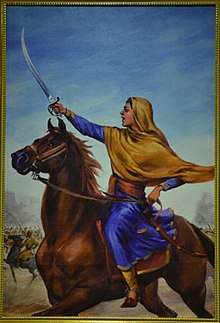Sada Kaur
| Sada Kaur | |
|---|---|
| Rani | |
 Rani Sada Kaur in battle | |
| Born |
c. 1762 Raoke Kalan Firozpur, Punjab, India |
| Died |
1832 (aged 69–70) Lahore, Punjab, India (present day Pakistan) |
| Spouse | Gurbaksh Singh Kanhaiya |
| Issue | Mahtab Kaur |
| Father | Daswandha Singh Dhaliwal |
| Religion | Sikhism |
Sada Kaur (Punjabi: ਸਦਾ ਕੌਰ; c. 1762 – 1832) was the chief of the Kanhaiya Misl from 1789 to 1821. She was the wife of Gurbaksh Singh Kanhaiya, the heir of Jai Singh Kanheya, the leader of the Kanhaiya Misl.[1]
After her husband's death in 1785 and her father-in-law's death in 1789, she became the chief of the Kanhaiya Misl.[2] An intelligent and ambitious woman, she was also the mother-in-law of Maharaja Ranjit Singh (the founder of the Sikh Empire) and played an important role in his rise to power in Punjab.
Early life and marriage
Sada Kaur was born into a Dhaliwal Jat family in 1762 to Sardar Daswandha Singh Dhaliwal.[3] She was married in 1766 to the 7 year-old Gurbaksh Singh, the eldest son and heir of Jai Singh, the head of the Kanhaiya Misl. They were married in 1768 and had one child together, a beautiful daughter named Mehtab Kaur, who was born in 1782.[4][5]
Leadership of the Kanhaiya Misl
Gurbaksh Singh died fighting in the Battle of Batala against the Sukerchakia Misl, the Ramgarhia Misl as well as the Sansar Chand Katoch. In 1785, Sada Kaur, along with Jai Singh Kanhaiya, then got her daughter married to Ranjit Singh, the Sukerchakia Misl's chief's son, and they were married in 1786.[6] In 1789, her father-in-law, Jai Singh Kanheya, also died.[6] Sada Kaur then assumed the leadership of the Kanhaiya Misl as well as the loyalty of its 8,000 cavalrymen.[4] After the death of his father, Mahan Singh, in 1792 Ranjit Singh was made the chief of the Sukerchakia Misl and Sada Kaur became his regent.[4] Sada Kaur used both Kanheya and Sukerchakia misals to push Ranjit forward.
The people of Lahore who were tired of the rule of Bhangi misl requested Sada Kaur and Ranjit Singh to take over Lahore. Sada Kaur advised Ranjit that whoever controls Lahore controls Punjab. On 7 July 1799 Ranjit Singh and Sada Kaur attacked Lahore with 25,000 troops. The people of Lahore opened the city gates for them. Ranjit entered the city through Lohari gate and Sada Kaur entered through Delhi gate. Sada Kaur made Ranjit Singh the king of Lahore in 1801.
In the battles for Amritsar, Chiniot, Kasur, Attock and Hazara she was with Ranjit Singh. In 1807 Ranjit Singh remarried. Sada Kaur did not approve of it. She broke with Ranjit. Then Sada Kaur thought of ruling her own state but Ranjit Singh restricted her movements. She retained the majority of her estates until 1820.[4] Sada Kaur died in Lahore in 1832.[7]
In popular culture
Sada Kaur is being played by Sonia Singh in Sher-e-Punjab: Maharaja Ranjit Singh on Life OK[8]
References
- ↑ Singha, H.S. (2000). The encyclopedia of Sikhism (over 1000 entries). New Delhi: Hemkunt Publishers. p. 137. ISBN 9788170103011.
- ↑ Roy, Kaushik (2015). Military Manpower, Armies and Warfare in South Asia. Routledge. p. 82. ISBN 9781317321286.
- ↑ Chilana, Rajwant Singh (2005). International bibliography of Sikh studies. Dordrecht: Springer. p. 408. ISBN 9781402030444.
- 1 2 3 4 Kakshi, S.R.; Pathak, Rashmi; Pathak, S.R.Bakshi R. (1 January 2007). Punjab Through the Ages. Sarup & Sons. pp. 272–274. ISBN 978-81-7625-738-1. Retrieved 12 June 2010.
- ↑ Noor, Harbans Singh (2004). Connecting the dots in Sikh history. Chandigarh: Institute of Sikh Studies. p. 67. ISBN 9788185815237.
- 1 2 Griffin, Sir Lepel Henry; Massy, Charles Francis (1890). The Panjab chiefs: historical and biographical notices of the principal families in the Lahore and Rawalpindi divisions of the Panjab. Civil and Military Gazette press. pp. 161–162. Retrieved 13 June 2010.
- ↑ Chilana, Rajwant Singh (2005). International bibliography of Sikh studies. Dordrecht: Springer. p. 408. ISBN 9781402030444.
- ↑ "Role in 'Sher-E...' seemed meaningful: Sonia Singh", The Times of India, 1 March 2017